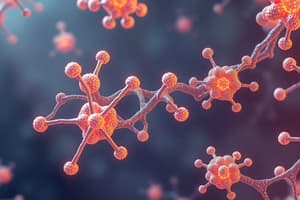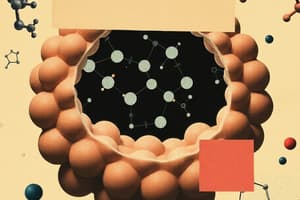Podcast
Questions and Answers
Which of the following statements accurately describes the difference between a nucleoside and a nucleotide?
Which of the following statements accurately describes the difference between a nucleoside and a nucleotide?
- A nucleoside consists of a nitrogenous base and a sugar, while a nucleotide also includes a phosphate group. (correct)
- A nucleoside is a polymer of nucleotides linked together by phosphodiester bonds.
- A nucleoside is specific to RNA, while a nucleotide is specific to DNA.
- A nucleoside contains a phosphate group, while a nucleotide does not.
In the context of protein structure, which type of interaction is primarily responsible for maintaining the secondary structure of a protein?
In the context of protein structure, which type of interaction is primarily responsible for maintaining the secondary structure of a protein?
- Ionic bonds between charged amino acid side chains
- Hydrogen bonds between the peptide backbones (correct)
- Covalent bonds between adjacent amino acids
- Hydrophobic interactions between R-groups
Which of the following best describes the role of enzymes in biochemical reactions?
Which of the following best describes the role of enzymes in biochemical reactions?
- Enzymes shift the equilibrium of a reaction towards the products.
- Enzymes increase the activation energy of a reaction, thus speeding it up.
- Enzymes lower the activation energy required for a reaction to occur. (correct)
- Enzymes are consumed during a reaction, causing it to proceed.
Which of the following features distinguishes cellulose from glycogen and starch?
Which of the following features distinguishes cellulose from glycogen and starch?
Which property of lipids allows them to form cellular membranes?
Which property of lipids allows them to form cellular membranes?
Flashcards
Carbon's Importance in biological chemistry
Carbon's Importance in biological chemistry
In biological chemistry, carbon's ability to form four bonds allows for the creation of diverse and complex molecules, essential for life.
Nucleotides
Nucleotides
Nucleotides are the building blocks of DNA and RNA. They consist of a phosphate group, a sugar (deoxyribose in DNA, ribose in RNA), and a nitrogenous base.
Proteins
Proteins
Proteins are polymers of amino acids. They are essential for many biological functions, including structural support, catalysis, and transport.
Enzymes
Enzymes
Signup and view all the flashcards
Polysaccharides
Polysaccharides
Signup and view all the flashcards
Study Notes
Preview of Cell Biology
- Some historical perspectives in biology
- Techniques used in biological inquiry
- Strands of biological inquiry
Macromolecules I
- Carbon and its importance in biological chemistry
- Different types of bonding and their relation to the strength of association
- Macromolecule synthesis: directionality, monomers, activated monomers
- Nucleic acids (DNA vs RNA): composition, structure, monomers, differences between nucleosides and nucleotides, base pairing, Chargaff's rule, Griffith S-R strain experiments
Macromolecules II
- Proteins: monomers (amino acids), directionality of synthesis, primary, secondary, tertiary, and quaternary structures, differences in bonding
- Enzymes: catalysts of life
- Activation energy barrier
- Catalyst properties
- Enzymes (proteins and RNA)
- Induced fit model
- Irreversible and reversible regulation (activation and inhibition) of enzymes
Macromolecules III
- Polysaccharides: monomers, structures (L-D isomers), roles inside a cell (structural and storage), examples (cellulose, starch, glycogen, pectin)
- Lipids: types of lipids, their function, amphipathic properties
Studying That Suits You
Use AI to generate personalized quizzes and flashcards to suit your learning preferences.




